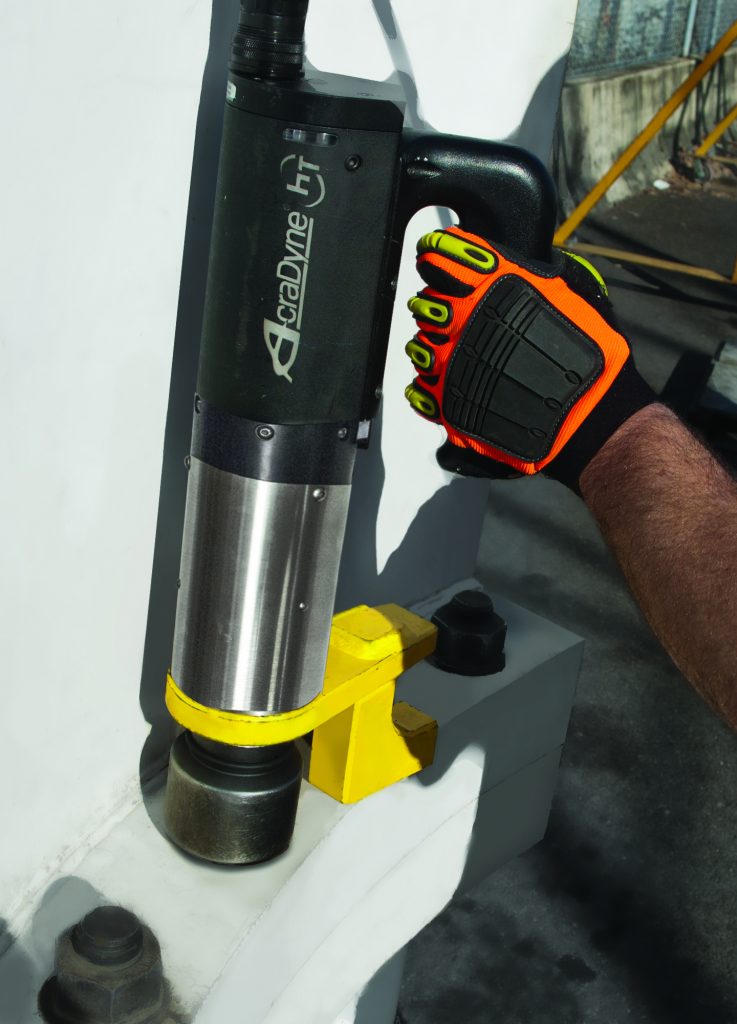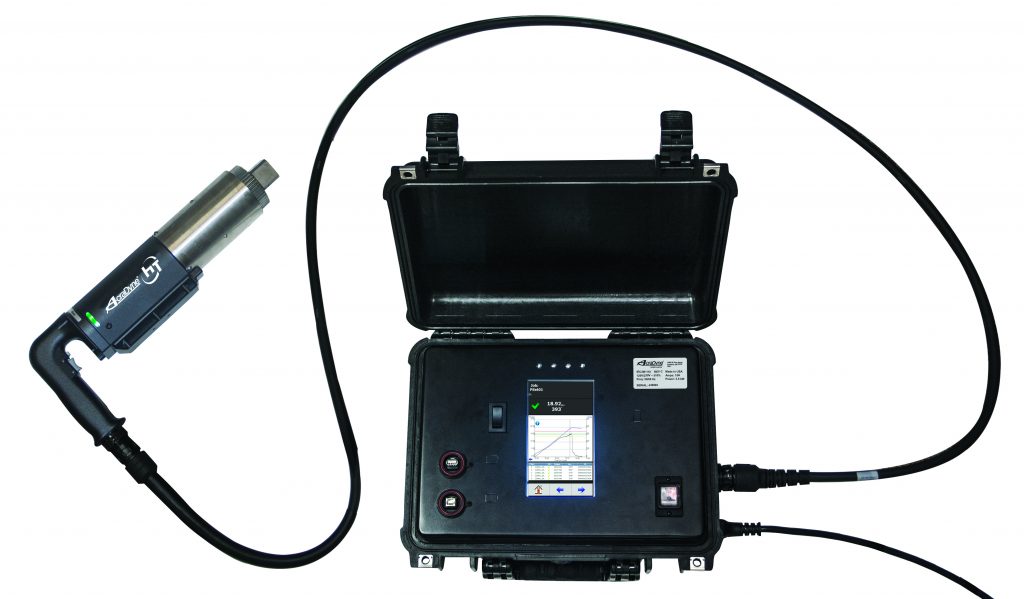Depending on the maker, a wind-turbine installation can include 25,000 bolts or more. These bolts follow different journeys to their final destination where correct installation is critical in order to keep these massive structures safely functional in high-load situations.
Whether the bolts are parts of an assembly put together in the factory, installed by technicians erecting the tower, or monitored for maintenance, they all have a common purpose. The bolted joint must create and maintain the tower designer’s intended clamping force (known as clamp load) to keep the components together. These bolts also have a service purpose in mind — they are removable components necessary for serviceability of the tower over its lifespan.
Bolt installation in a wind-turbine joint can be done using several different methods. These methods range from the simple (hand wrench/hand install) to the sophisticated (controlled tooling with data-reporting capabilities).
For many years, installation technicians used a variety of hand wrenches, manual torque multipliers, impact wrenches, and hydraulic power tools to accomplish these tasks. Each of these technologies had its place and still does.
Installation challenges
Bolt installation has several challenges. Wind turbines are growing in size and output. Where a 1.5-MW tower was common and, in its day, considered large, current tower designs have outputs of 12 MW with larger designs still on the drawing board at most of the major makers. Larger output leads to significantly larger tower structures that require higher torque for assembly. Installations must meet the ever-growing requirement that all tasks are done 100 percent correctly without human error.
Technicians are in relatively short supply, and experienced ones are in great demand. Each of these people must have proficiency in a multitude of skill areas to work on turbines. A short list of what these people are tasked with include climbing, safety protocols, working with and around high-voltage equipment, rigging, and torque — all in harsh environments.
Torque values for the fasteners, which once were 1,000 NM to 5,000 NM in range, have increased significantly. What used to be the highest requirement for a tightening solution — 5,000 NM — has now been eclipsed with torque targets of 12,000 NM on many of the offshore installations. Makers are reporting that future torque targets will be 15,000 NM and beyond.

As a result of these challenges, traditional methods that depend on the human element need to change. Tower manufacturers and the farm operators tasked with running them are realizing that monitoring the assemblies within the turbine is the only way to maintain confidence in their integrity.
Speed of work also is an important factor. Farms are being deployed in environments (offshore for one) where running costs of crews are significantly higher, and delays drastically affect the installation.
So, manufacturers and farm operators do have some common objectives that the current tooling market is responding to: productivity, ergonomics/safety, tool reliability, and quality of the assembly.
New solutions
New solutions have moved the industry toward achieving these objectives. High-speed (relative to existing solutions) controlled tools can be configured with presets that assist a technician in running a specific job. These presets can be configured by torque-knowledgeable personnel prior to tower work so that the technician up in the tower can simply apply the tool to the bolt and complete the tightening. Preset bolt-counting sequences can further assist the technician in completing all bolts required and identifying situations where one or more may have been missed.
Much of the innovative work in bolt-tightening tooling is about management of the process and recording data from the job. As in aerospace and even vehicle manufacturing, bolts within the turbine are critical to its safe and successful operation. For years, a major gap in the assembly and maintenance procedures for these assets has been a lack of hard data from the handling of the tightening task. Was a bolt tightened properly? Were all of the bolts tightened correctly? Were the bolts the correct quality from the supplier? How can this information be obtained, confirmed, and documented over the lifespan of the tower? Tools that have the ability to control the tightening, collect data, and report it to a database are becoming vitally important.
Impact wrenches
Impact wrenches are operator dependent and record no results. Manual procedures with torque multipliers can present data results, but are also operator dependent for constancy. Hydraulic wrenches with their power units produce some data but rely on a pressure gauge and consistent ambient conditions for consistent output.
Many of these techniques rely on an operator component to record the work. Paper and pen records and transportation of these papers back to the office introduce the human element into the equation. These issues, coupled with the technology capabilities of today, beg for systems that are highly accurate in recording data and that provide automated means of keeping records. Systems that are now in demand have repeatably accurate sensors, drive the process, and store the data.
Configuring a torque-driving tool to sense-applied torque is possible via various means. Many systems employ electrical current or hydraulic pressure-sensing gauges that measure the energy used (electrical current or fluid pressure) while driving the bolt. These systems are capable of generating results data but are not repeatable over time due to variations in electrical motor demands, fluid pressure changes from leaks, or ambient temperature changes. To remain credible, these systems require extremely frequent calibrations so that the results are truly what their gauges indicate.

Industry leading systems use a sensor located as close to the bolt being driven as is practically feasible. In tool design, this means placing the sensor at the location of the socket that turns the bolt. By using a sensor that is independent of the energy source used to deliver the torque, these results are repeatable and hold a calibration for as long as one year from verification. These types of sensors, known as strain gauges, have been widely used in assembly applications for years. In laymen’s terms, they measure the strain experienced at the material they are bonded to and, through a processor in the control unit, report a repeatable torque value.
Measuring angle of rotation
An added benefit of systems of this type is the ability to also measure the fastener’s angle of rotation. Systems can be configured to sense initial torque at a point in the process where the materials are all in contact and tightening is beginning. From that “snug” point, the system observes, reports, and can even control the amount of bolt rotation until complete. This capability aids in the detection of cross-threading and any anomalies in the tightening, giving a qualified “good/no good” judgment to the operator and noting it in the data. Sophisticated graphical imagery can also be plotted from each moment of the tightening process. This “curve” can be used to compare results from known good tightening events to current events, highlighting minute changes in materials, bolts, or operator technique. The benefits of this analytical information are widespread, particularly when reviewing problems or historical trends within specific joints on a tower or series of towers. Common goals are repeatable quality, traceability, and eliminating as many human-element mistakes as possible within a process.
Future trends will revolve around collection of this increasingly available data, management of the data, and real-time observation of what is happening within the turbine from global locales. Offshore wind turbines are a huge growth area where farm deployment and management can be logistically difficult. Tower designs are now being outfitted with network communications for turbine operation, and these connections can and will be used to work with tightening tools as well.
Real-time data
Farm installation and service managers desire an ability to “see” what the tightening tools are doing in real time from outside the tower. Today’s tightening systems can provide that visibility. A bolt-tightening system can be configured to transmit the results data in real time over networks back to a central data repository and to the manager’s location. This information can then be filed in real time to a Quality Management System (QMS) database. These databases are repositories for all of the data associated with a specific joint on a specific tower, on a specific date, at a specific time, even with a specific operator if so desired.
Another benefit is the ability to program the tightening system from remote locations. This is beneficial when main farm management desires to upload a tightening strategy to a tightening system. This can be integral in systems where the central office controls process revision. It eliminates the need to track down and change every control unit in use. The controlling unit is connected to the network prior to use, and only then would the specific process be uploaded, ensuring that the latest revisions are current in the tightening system’s programming.
Today, farm installers, operators, and maintenance personnel have the power to perform bolting at a highly technical level. No longer is it necessary or required to manually tighten bolts in faraway places. Turbines becoming more massive and prevalent, and the increasing importance of the energy they produce means that keeping them operating in a safe and reliable manner is critical.
























